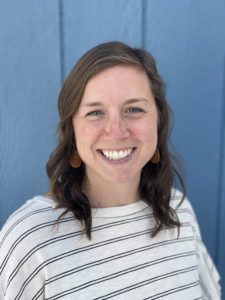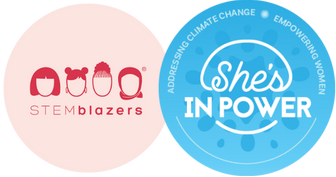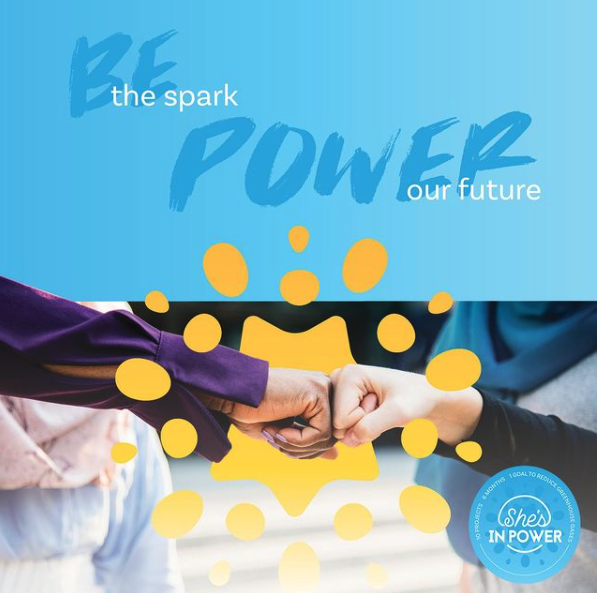Diane Ernst first heard about She’s in Power and the program manager position through the Sustainable Living Association. After reading the job description, she was all in.
“I’m super passionate about empowering the next generation,” enthused Ernst. “I thought the position would give me the ability to do that while tangibly helping tackle the real issue of women in clean energy. I wanted to be part of it.”
Get to know She’s in Power’s new program manager, Diane
 How did you first hear about Colorado C3E and She’s in Power?
How did you first hear about Colorado C3E and She’s in Power?
This year, I completed a training with the Sustainable Living Association. Through that, I learned about the job opening for She’s in Power. I thought it was a great fit, and I applied for the position in the fall.
What made the position feel like a good fit?
Reading the job description got me to the C3E website, where I learned about how C3E got started and the passion behind the initiative of getting women in clean energy. It spoke to me. In terms of the She’s in Power job itself, I’m super passionate about empowering the next generation, and I thought the position would give me the ability to do that while tangibly helping tackle the real issue of women in clean energy. I wanted to be part of it.
Your work with the City of Fort Collins is a great springboard to She’s in Power. How will your experience inform your work for She’s in Power?
A big part of what I do at the City is work to fill gaps in programming. There are a lot of environmental education providers in Northern Colorado, but I saw a gap in reaching teenagers and providing free, educational, stimulating programming for them in Fort Collins. Working for the City allowed me to start a club for teenagers where we work on environmental stewardship, leadership and climate action. She’s in Power is also about filling a gap in programming — reaching out to and providing opportunities for a certain subset of the community. That’s what sparked my interest. The program I run at the City is only a small part of my job, but it’s what I love most — empowering those teenagers. She’s in Power gives me the opportunity to do more of what I love.
The She’s in Power program is part of the overall C3E mission of empowering women and girls. Have you encountered any challenges as a woman in your profession? How did you overcome them?
I’ve been in public engagement and environmental education for over 10 years. There are a lot of women in this field, but what’s difficult for women is moving out of an education position and into a leadership position. A lot of upper-level management is run by men. Including more women in the leadership, planning and more management-level positions in this field has been a challenge.
For me, the greatest thing I’ve been able to do is find mentors and strong women in the field who can coach and inspire me. That’s been a huge game changer. And I’ve worked to widen my skillset, find professional development opportunities, and network and meet people. All these things have allowed me to excel in other areas and be able to move up.
I’m one of those people who is not afraid to network; it comes easy for me. But now I’m trying to be a mentor and find opportunities for other people who might have a harder time being comfortable networking and reaching out — because it can be a little intimidating.
Your background is in education, which is a big part of C3E. How do you think educators themselves can inspire more girls and women to stick with STEM-related fields?
The way I view it, exposure at a younger age is huge. So when girls have decisions to make about what they want to do, they know these areas of study and fields exist. The biggest gap is just not knowing that these things exist. One way to combat that is finding schools that provide STEM opportunities. What’s great about She’s in Power is it helps girls and women find opportunities outside the normal school day and school system. It’s a great way to foster skills and then find friends who might be interested. If your child is expressing an interest in something, finding opportunities for them to be able to dive deeper is really important.
As Program Manager, you have the opportunity to help shape She’s in Power. What is your vision for the program?
A big focus for the next few years will be making the program more equitable and inclusive — not just reaching young women and girls, but also young women and girls of color. We’re willing and able to take on the challenge of getting She’s in Power in front of people who don’t know it exists, to change the way we market and communicate to get this program out in the community so it can be accessible for everybody. And within our programming, making the projects themselves inclusive, equitable and accessible.
Another focus is building a pipeline for She’s in Power. Now that people have been through the program, we have a group of alumni. How do we keep people engaged? We’re talking about providing opportunities for people even after they’re done with their Power Projects. So maybe that means a Spark becomes an Energizer or an Energizer becomes a Power Partner, or a Power Partner donates money to continue the program.
Part of building a pipeline is sharing stories. That’s another part of our vision — getting the word out and encouraging people to share how the program has impacted them. Opportunities like this are a little hard to measure immediately. But what if somebody, let’s say, does a Power Project, and then two years later, gets a job in the clean energy field? Let’s tell that story! That’s so exciting and allows more people to see women in clean energy, to spark that inspiration to do this work.
We’re also working on scalability. I truly believe in a collective impact and that you should always be working yourself out of a job. If we can package She’s in Power, another community can take it on. There’s so much power and greatness in this program. Let’s scale it up and share it to other communities and places outside Northern Colorado.
I’ve been spending the past couple of months learning how She’s in Power got started and how it has come to fruition. So much great work has happened to build a foundation for the program. I’m excited to open up doors, hear from people, meet people and really get things going. I think we’ll be able to grow our impact on the community, which is what it’s all about.
What does sustainability mean to you personally?
For me, sustainability is the way of the future. The reason I’m so passionate about the people side of it is because I would love to bring sustainability into everybody’s lives, no matter what that looks like. Maybe it’s inspiring somebody to take a personal interest in sustainability, so they start composting in their kitchen. No matter what form it takes, there’s a need for sustainability to be brought to the forefront.
The sustainability piece I’ve become passionate about lately is the concept of intersectional environmentalism. Sustainability is a way of taking care of the planet, but it’s also about taking care of people. The more we understand that those two things are intertwined and that climate change impacts people, especially people of color and low-income families, the more we’re going to be able to make strides in helping with climate action and sustainability.

